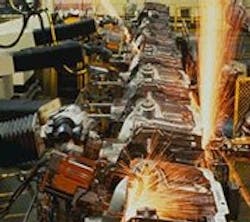Motor starters are old technology, but they're also everywhere. Traditional starters using contactors, solenoids and coils have been the primary method for starting and stopping three-phase motors for decades, so they have an installed base that's invisible because it's been so durable. Most motor starters comply with standards from the National Electrical Manufacturers Assn. (www.nema.org) or the International Electrotechnical Commission (www.iec.ch).
Sure, starters have been replaced in applications that need soft starting and variable-speed control, but there's far more equipment that needs immediate, across-the-line power. The downside is that a motor starter can pull six to 10 times the nominal voltage when it's energized, and this can wear out mechanical components more quickly.
Because of these factors, Fabrice Meunier, marketing manager for low-voltage products at Schneider Electric (www.schneider-electric.com), says the motor starter market still grows because there are so many pumps and fans that need to run at a constant speed. "This field is transitioning to more-efficient motors and drives that aid efficiency, but if you don't need variable speed, then starters are still more efficient, use less energy and give users a better bang for their buck," Meunier argues. "And more intelligent components, smarter networking and built-in diagnostics have been added to many starters to secure more data, too."
Motors starters are a low-cost and still highly viable technology, and are in fact ideal for many applications, explains Brian Griffin, marketing specialist for ABB's (www.abb.us) low-voltage products. "Motors starters are old school, but many engineers still like to use NEMA starters because they've been so reliable for their critical compressors, chillers and material handling applications. Many fans and pumps have gone to soft starters and variable-speed drives (VFDs), but a lot of fans and especially fire pumps still use regular starters. And many users want to keep using starters because they don't have a lot of new expertise and they're short-staffed, so they can replace a starter without having to consult design drawings."
VFDs have many advantages and have experienced huge growth in the past 30 years, but only 30% of all motors have drives on them, according to Rob Fenton, product manager for Eaton (www.eaton.com). Also, he adds, microprocessor-based soft starters are two to three times as expensive as a regular motor starter, and drives can be eight to 10 times more expensive than a starter. "Generally, starters are getting smaller, even less costly due to better designs, even more reliable, and more globally standardized and accepted," he says. "The same starters are being used in the U.S., Europe and China, and that's driving up the ability for more users to adopt them. We also see starters engineered with more advanced materials, so they're more robust and lighter-weight, and they're adding intelligence and communications options, too."
In recent years, some European motor manufacturers have integrated starters inside the motor, instead of in panels where they're usually located. "About 15 years ago, we mounted a VFD in a motor with our MoviMot solution, but many of the automobile industry guys said they also wanted a starter integrated with a motor for decentralized control, so we developed Movi-Switch about 10 years ago," says Rich Mintz, product marketing manager for SEW-Eurodrive (www.seweurodrive.com). "They liked getting all the voltage and full torque immediately, which you need in equipment like hoists, so they don't drop or sag. To do this with a VFD, you may need a closed-loop drive or a servo, and that would cost a lot more. A motor starter is like the manual transmission in a car. There's no need to abandon it if it still works great, and in some applications a starter works better. And now, we can take old, hardware-based starters, put in new control topologies with fieldbus or Ethernet connections, and use them for monitoring."
About the Author
Jim Montague
Executive Editor, Control
Jim Montague is executive editor of Control. He can be contacted at [email protected].

Leaders relevant to this article:

